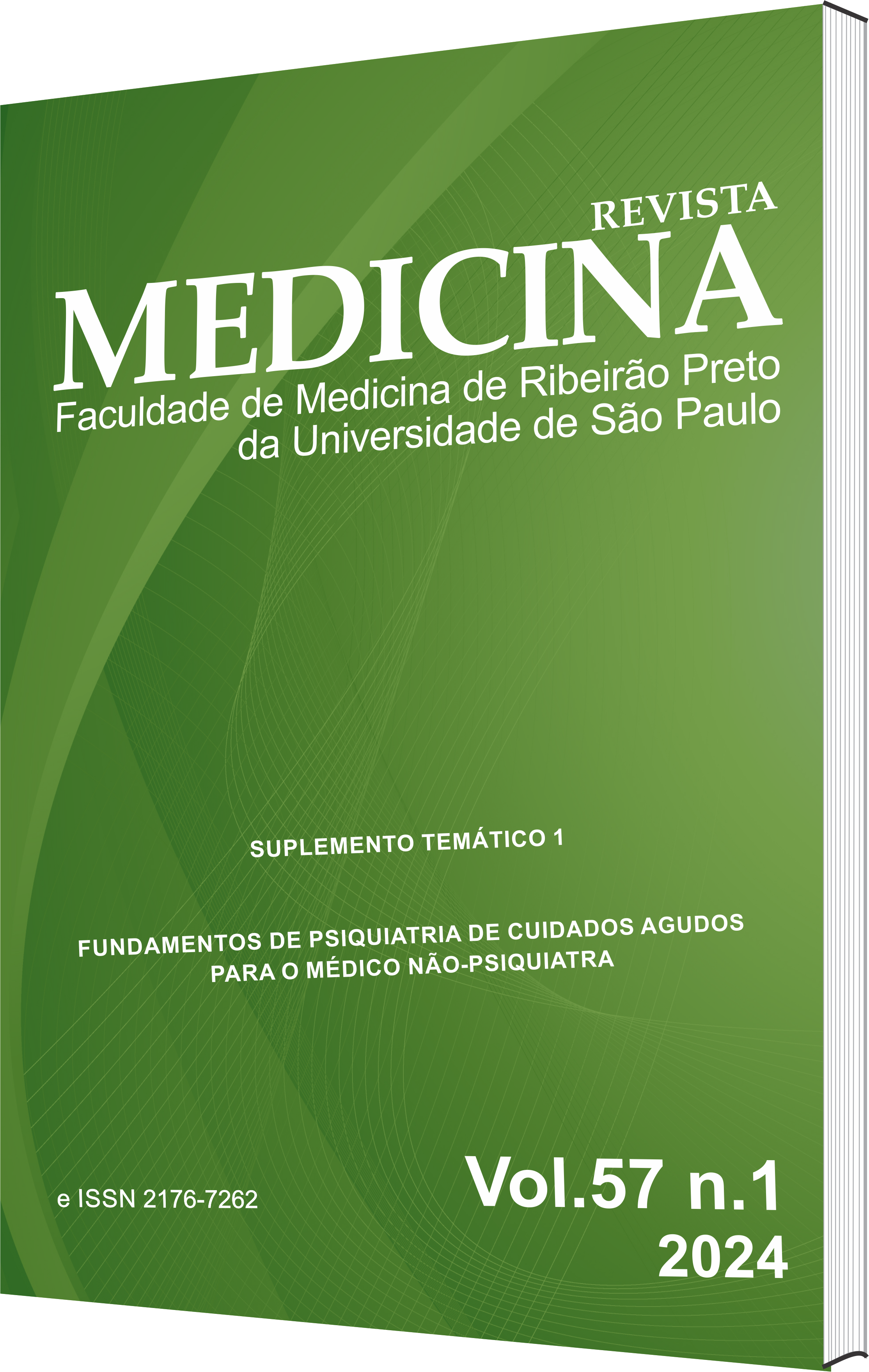O desafio da agitação psicomotora na prática clínica
DOI:
https://doi.org/10.11606/issn.2176-7262.rmrp.2024.221903Palavras-chave:
Agitação psicomotora, Paciente violento, Desescalada do comportamento, Tranquilização rápida, Tratamento, Intervenção farmacológicaResumo
Neste artigo discutiremos aspectos clínicos no manejo da agitação psicomotora, uma condição clínica que ocorre com frequência em setores de atendimento de saúde de urgência. O manejo da agitação psicomotora pode ser desafiador para o profissional de saúde, especialmente devido aos riscos que podem estar associados, quer seja para o paciente ou para a equipe de saúde. Por esta razão, a utilização de uma tomada de decisão baseada em um protocolo passo-a-passo é de fundamental importância para o sucesso. Deve-se iniciar tendo em conta os três passos fundamentais no manejo de agitação, a saber: ambiental, atitudinal, e farmacológico. Estes passos podem ser resumidos em: resolver ou mitigar qualquer causa médica geral de base, garantir a segurança do paciente e equipe (ambiental), manejo atitudinal através de técnicas de desescalada do comportamento, e, como último recurso, intervenções farmacológicas. A segurança do profissional na aplicação destes princípios é de fundamental importância na prevenção de consequências sombrias da agitação psicomotora, como ferimentos graves e trauma emocional para pacientes e equipe de saúde, e no tratamento adequado da condição médica geral e/ou psiquiátrica que esteja precipitando a agitação.
Downloads
Referências
Chevrolet JC, Jolliet P. Clinical review: Agitation and delirium in the critically ill – significance and management. Crit Care. 2007;11(3):214.
Nordstrom K, Zun LS, Wilson MP, Stiebel V, Ng AT, Bregman B, et al. Medical evaluation and triage of the agitated patient: consensus statement of the american association for emergency psychiatry project Beta medical evaluation workgroup. West J Emerg Med. 2012 Feb;13(1):3–10.
Zeller SL, Rhoades RW. Systematic reviews of assessment measures and pharmacologic treatments for agitation. Clin Ther. 2010;32:403–25.
Mantovani C, Migon MN, Alheira FV, Del-Ben CM. Manejo de paciente agitado ou agressivo. Revista Brasileira de Psiquiatria. 2010 Oct;32(suppl 2):S96–103.
Weltens I, Bak M, Verhagen S, Vandenberk E, Domen P, van Amelsvoort T, et al. Aggression on the psychiatric ward: Prevalence and risk factors. A systematic review of the literature. PLoS One. 2021 Oct 8;16(10):e0258346.
Huf G, Alexander J, Gandhi P, Allen MH. Haloperidol plus promethazine for psychosis-induced aggression. Cochrane Database of Systematic Reviews. 2016 Nov 25;2016(11).
George C, Jacob TR, Kumar A V. Pattern and correlates of agitation in an acute psychiatry in-patient setting in a teaching hospital. Asian J Psychiatr. 2016 Feb;19:68–72.
Lawrence RE, Rolin SA, Looney D V, Birt AR, Stevenson EM, Dragatsi D, et al. Physical Assault in the Psychiatry Emergency Room. J Am Acad Psychiatry Law. 2020 Dec;48(4):484–95.
Wong AH, Ray JM, Eixenberger C, Crispino LJ, Parker JB, Rosenberg A, et al. Qualitative study of patient experiences and care observations during agitation events in the emergency department: implications for systems-based practice. BMJ Open. 2022 May;12(5):e059876.
Rossi J, Swan MC, Isaacs ED. The violent or agitated patient. Emerg Med Clin North Am. 2010 Feb;28(1):235–56, x.
Meehan KM, Wang H, David SR, Nisivoccia JR, Jones B, Beasley CM, et al. Comparison of rapidly acting intramuscular olanzapine, lorazepam, and placebo: a double-blind, randomized study in acutely agitated patients with dementia. Neuropsychopharmacology. 2002 Apr;26(4):494–504.
Mantovani C, Labate CM, Sponholz A, de Azevedo Marques JM, Guapo VG, de Simone Brito dos Santos ME, et al. Are Low Doses of Antipsychotics Effective in the Management of Psychomotor Agitation? A Randomized, Rated-Blind Trial of 4 Intramuscular Interventions. J Clin Psychopharmacol. 2013 Jun;33(3):306–12.
Holloman G, Zeller S. Overview of Project BETA: Best Practices in Evaluation and Treatment of Agitation. Western Journal of Emergency Medicine. 2012 Feb 1;13(1):1–2.
Hoffmann JA, Pergjika A, Konicek CE, Reynolds SL. Pharmacologic Management of Acute Agitation in Youth in the Emergency Department. Pediatr Emerg Care. 2021 Aug 1;37(8):417–22.
Baldaçara L, Ismael F, Leite V, Pereira LA, dos Santos RM, Gomes Júnior V de P, et al. Brazilian guidelines for the management of psychomotor agitation. Part 1. Non-pharmacological approach. Brazilian Journal of Psychiatry. 2019 Apr;41(2):153–67.
Vieta E, Garriga M, Cardete L, Bernardo M, Lombraña M, Blanch J, et al. Protocol for the management of psychiatric patients with psychomotor agitation. BMC Psychiatry. 2017 Dec 8;17(1):328.
Mantovani C, Del Ben CM. Estudo comparativo de intervenções farmacológicas para o manejo de agitação psicomotora aguda. Universidade de São Paulo; 2015.
Spencer S, Johnson P, Smith IC. De-escalation techniques for managing non-psychosis induced aggression in adults. Cochrane Database of Systematic Reviews. 2018 Jul 18;2018(7).
Richmond J, Berlin J, Fishkind A, Holloman G, Zeller S, Wilson M, et al. Verbal De-escalation of the Agitated Patient: Consensus Statement of the American Association for Emergency Psychiatry Project BETA De-escalation Workgroup. Western Journal of Emergency Medicine. 2012 Feb 1;13(1):17–25.
Nordstrom K, Allen MH. Managing the Acutely Agitated and Psychotic Patient. CNS Spectr. 2007 Nov 7;12(S17):5–11.
Baldaçara L, Rocha GA, Leite V da S, Porto DM, Grudtner RR, Diaz AP, et al. Brazilian Psychiatric Association guidelines for the management of suicidal behavior. Part 1. Risk factors, protective factors, and assessment. Brazilian Journal of Psychiatry. 2021 Oct;43(5):525–37.
Baldaçara L, Diaz AP, Leite V, Pereira LA, dos Santos RM, Gomes Júnior V de P, et al. Brazilian guidelines for the management of psychomotor agitation. Part 2. Pharmacological approach. Brazilian Journal of Psychiatry. 2019 Aug;41(4):324–35.
Yatham LN, Kennedy SH, Parikh S V, Schaffer A, Bond DJ, Frey BN, et al. Canadian Network for Mood and Anxiety Treatments (CANMAT) and International Society for Bipolar Disorders (ISBD) 2018 guidelines for the management of patients with bipolar disorder. Bipolar Disord. 2018 Mar;20(2):97–170.
Hirsch S, Steinert T. The Use of Rapid Tranquilization in Aggressive Behavior. Dtsch Arztebl Int. 2019 Jun 28;116(26):445–52.
Gerson R, Malas N, Feuer V, Silver G, Prasad R, Mroczkowski M, et al. Best Practices for Evaluation and Treatment of Agitated Children and Adolescents (BETA) in the Emergency Department: Consensus Statement of the American Association for Emergency Psychiatry. Western Journal of Emergency Medicine. 2019 Feb 28;20(2):409–18.
Downloads
Publicado
Edição
Seção
Licença
Copyright (c) 2024 Célia Mantovani

Este trabalho está licenciado sob uma licença Creative Commons Attribution 4.0 International License.







